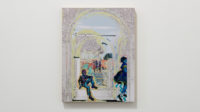Washington, D.C.
Maureen Moran, whose studio, MCLA, counts among the four largest lighting consultancies in the nation’s capital, can design an office for a Washington attorney in her sleep. “Coves, everything concealed,” she describes without a moment’s hesitation. “[D.C.] law firms like dark wood, but it looks great only under halogen.” Which, she adds, is difficult to use due to increasingly stringent sustainability mandates.
The work in question is a new 10-story office mid-rise and an atrium that connects it to the adjacent six-story Acacia Building — a 1935 structure designed by Shreve, Lamb & Harmon that was expanded in 1953 and is now largely occupied by the respected law firm Jones Day. Commissioned in 2004 by Chevy Chase, Maryland–based developer the JBG Companies, this is RSHP’s first commercial office in the United States.
The new building provides flexible tenant space for Jones Day and potential future tenants. The accompanying 12,000-square-foot atrium is the bond that integrates the disparate parts into a unified campus with undeniable character. Central to RSHP’s scheme is a yellow structural steel tree that contains vertical circulation and links office spaces via frosted-glass bridges. This core sprouts yellow boomerang trusses that brace the atrium’s cantilevered floating glass roof and appear as giant stitching. According to Austin, “The ambition of the project was to unite the buildings and reorient them toward the tree structure,” adding that the exposed and color-coded systems provide legibility. It is this easy-to-read anatomy that Moran responded to. “I thought bare fluorescents were the right thing to do,” she says.
“It’s great that people would see [the lamps] and appreciate them for what they’re worth,” Austin recalls, referring to Moran’s proposal. Today T5 tubes are tucked within yellow flanges, outlining the tree’s structure. In addition, two through-wired lines of the lamps edge the underside of every interior bridge.
Celebrating such muscular architectural vocabulary also helped to satisfy issues of functionality. “I knew everybody was going to be focused on getting enough light on those bridges,” Moran explains. Because atriums are so infrequent in Washington, D.C., building owners like JBG adhere to strict light-level requirements. For instance, the steps had to be illuminated to a level of one foot-candle. To achieve this, Moran applied the same fluorescent lamps beneath the edges of each of the tree’s trapezoidal landings.
Likewise, Moran strapped two luminaires along the length of one of the three tree trunks. Powerful metal-halide lamps, lined with an optical light film that helps to distribute the illumination more uniformly, are installed at the top and bottom of these multistory cylinders. This strategy creates a core of light around which the stairways wrap. Moreover, the lighting design team installed metal-halide par 30s at the top of the Acacia Building that point toward faceted reflectors suspended from the atrium ceiling, resulting in a diffuse luminance throughout the space.
Indeed, Moran — a native Washingtonian with a fondness for the early building’s architecture — not only employs the Acacia Building as a means of intensifying the atrium light; she celebrates it. Yet “it had to be treated differently from the tree,” she notes. So while she made the tree a focal point, she inserted metal halide uplights with linear-spread lenses into the ground floor to graze the old limestone facade. She then continued this approach to the exterior of the Acacia Building. Outside, metal halides light the underside of the atrium roof. An elevator core, expressed on the exterior of the new office in frosted glass, is grazed by LEDs.
A sense of balance — keeping the historic from being overpowered by the new — informs Moran’s entire lighting plan. She illuminated the major structural elements of the atrium tree, because “the colors make a statement.” She even installed lighting controls for special events. Entire branches can go dark to direct attention to specific areas in the complex. Employees and visitors, however, benefit most of all. The T5s are dimmable, says Moran, “so people actually look good under these fluorescents.”
People
Architect:
Partner in Charge:
Associate Project Designer:
Architect of record:
Engineer(s):
Consultant(s):
Lighting:
General contractor:
Photographer:
Blake Marvin/HKS |
Products
Lighting TIR Light Pipe (contact-Philips-David Kriebel 604-473-2320 )
Atrium Downlight:
Atrium Uplight:
Back Lit Elevator Enclosure:
Exterior: BK Lighting (contact- Lighting Environments- Tim Gunther 301 470 3282)
Dimming System or other lighting controls: |






Post a comment to this article
Report Abusive Comment